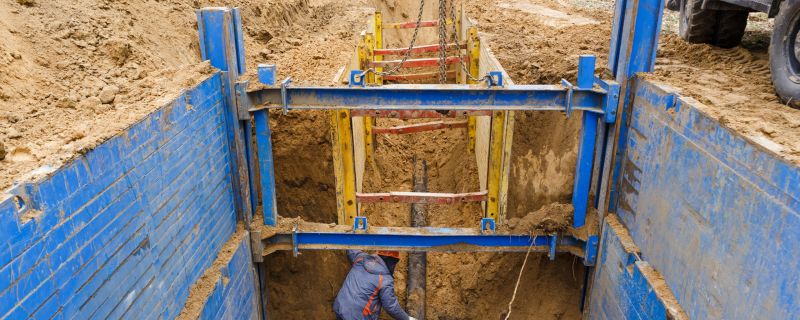
- Claims & Risk Management
- 4 comments
Slope it, shore it, shield it, are words to live by if you or any employees are exposed to excavations. The Occupational Safety & Health Administration defines an excavation as any man-made cut, cavity, trench, or depression in the earth’s surface formed by earth removal. Trenching and excavation work exposes workers to extremely dangerous hazards. Cave-ins pose the greatest risk and are much more likely than other excavation related accidents to result in worker fatalities. Other potential hazards include falls, falling loads, hazardous atmospheres, and incidents involving mobile equipment. Trench collapses cause dozens of fatalities and hundreds of injuries each year.
According to the Census of Fatal Occupational Injuries (CFOI) data, published by the Bureau of Labor Statistics (BLS), there were 130 fatalities recorded in trenching and excavation operations between 2011 and 2016. The private construction industry accounted for 80%, or 104, of those fatalities. An alarming 49% of those construction fatalities occurred between 2015 and 2016. The increase in fatalities in recent years is a sure sign that trenching safety awareness needs to increase to save lives.
OSHA standards on trenching and excavation can be found under the following: 29 CFR 1926.650, 29 CFR 1926.651, and 29 CFR 1926.652.
Requirements include:
- Trenches 5 feet (1.5 meters) deep or greater require a protective system unless the excavation is made entirely in stable rock.
- Trenches 20 feet (6.1 meters) deep or greater require that the protective system be de-signed by a registered professional engineer or be based on tabulated data prepared and/ or approved by a registered professional engineer.
- Daily inspection of trenches by a competent person prior to worker entry and as conditions change to ensure elimination of excavation hazards.
- Safe access and egress to all excavations, including ladders, steps, ramps, or other safe means of exit for employees working in trench excavations 4 feet (1.22 meters) or deeper. These must be located within 25 feet (7.6 meters) of all workers.
Protective Systems: There are different types of protective systems. Sloping involves cutting back the trench wall at an angle inclined away from the excavation. Shoring requires installing aluminum hydraulic or other types of supports to prevent soil movement and cave-ins. Shielding protects workers by using trench boxes or other types of supports to prevent soil cave-ins. Designing a protective system can be complex because you must consider many factors: soil classification, depth of cut, water content of soil, changes due to weather or climate, surcharge loads and other operations in the vicinity.
Competent Person: A competent person is an individual who can identify existing and predictable hazards or working conditions that are hazardous, unsanitary, or dangerous to employees; and who is authorized to take prompt corrective measures to eliminate or control these hazards and conditions.
General Trenching and Excavation Rules
- Keep heavy equipment away from trench edges.
- Keep surcharge loads at least 2 feet (0.6 meters) from trench edges.
- Know where underground utilities are located.
- Test for low oxygen, hazardous fumes and toxic gases.
- Inspect trenches at the start of each shift.
- Inspect trenches following a rainstorm.
- Do not work under raised loads.
Employers engaged in excavations should identify their worksite trenching hazards and train their workforce to eliminate or control these hazards. OSHA will make it a priority to inspect open trenches to reduce the number of injuries and fatalities. They are asking for employers to do the same. For training materials and additional information Visit OSHA’s Safety and Health Topics web page on trenching and excavation at http://www.osha.gov/SLTC/trenchingexcavation/ index.html .
Please engage The Safegard Group’s Risk Control Department to assist with education and training. Don’t just think about protecting your employees, protect them! Remember Slope it, Shore it, Shield it!!


4 Comments
Thanks for this advice for trenching. I’m glad that you mentioned the important of having daily inspections of the trenches. I wonder if ti could be good to have multiple inspections throughout the day to make sure everything is going well with the trench.
Yes, you’re correct. Ideally, multiple inspections per day ensure greater safety but may be cost and/or prohibitive for many companies unfortunately.
Generally using the shore method for our residential projects, haven’t had much experience using “shielding” as a protective method. Should use it more though!
Thanks for the article, don’t see stuff like this very often on the internet!
It is really interesting that a simple way to protect a trench is to slope one trench wall away from the excavation. Knowing this would be extremely helpful because then you could be sure that you are going to dig a trench that will not collapse or fill up with dirt and grime. Hiring a professional who knows how to do all of the protective measures would probably be a sound thing to do if you need something dug for you.